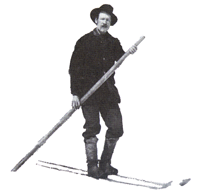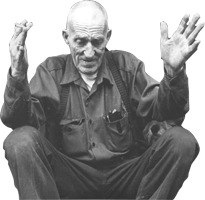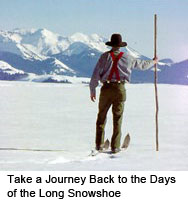The story of Lum Turner first appeared in my book Winter Tales and Trails. If there is anyone that I've come to know that best fits the ideal mold of a backcountry old-timer it is Lum. Here's a brief glimpse of his pioneering life.
I am a pocketor of old ski stories. You know, the kind of folklore that comes from the days when all skiing was cross-country skiing: no crowds, no high-speed quad lifts, no thousand-dollar plastic boots. It was a simple time when skiers used their own strength to get around and all skis were made from wood.
Of course, those days--and those hardy skiers--are long gone. But once in the mid 1970s, I got a chance to meet an old-timer who had been a part of that life. His name was Lum Turner. The 24 hours that I spent with Lum was a whirlwind of experiences and stories that I'll never forget. It was fascinating, rewarding--and sometimes even wonderfully bizarre. 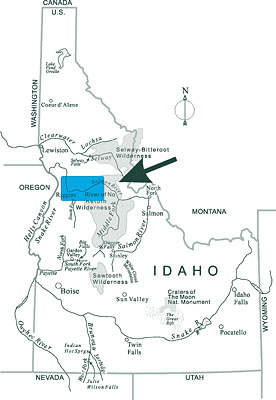
I first met Lum Turner in the town of Riggins, a small berg hemmed in by the Salmon River and canyon walls in west central Idaho. It was a cold, winter day, and after a cross-country ski tour, I had stopped in Riggins to warm up at one of the local watering holes. Seated near me at the bar was Lum, a tall and lean man with strikingly large hands, obviously weathered by years of work in the outdoors.
I started a conversation with him, and it quickly led to skiing. He told me about making his own skis, what types of wood he favored, and the way in which he fashioned the tip, and how he used skis in his work. I must have been still chilled from my tour, for it took some time before it struck me. Amazed, I lean back in my chair, and looked closely at the octogenarian sitting before me. He was the answer to a dream, a golden connection to the past, a surviving member of that gritty breed of real men and women who made, used and worked on wooden skis.
At the time, I was working on a book about the history of cross-country skiing in Idaho. For research, I had mostly been pouring over old manuscripts and newspapers. Yet, you can learn only so much from written material. At some point if you really want to understand things you have to talk to people who have lived and experienced the old days. I had searched the state for old-timers, and interviewed many, but I was missing the one person that really could tell me what it was like--until, purely by chance, I came upon Lum.
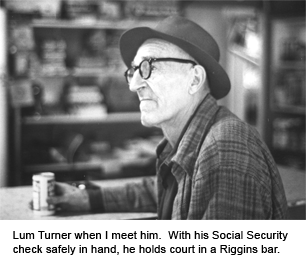 Life is like that at times. Sometimes you put your heart and soul into a project, and the harder you try, the further the goal eludes you. Then out of the blue, when it is least expected, the person that you need the most in your life appears.
Life is like that at times. Sometimes you put your heart and soul into a project, and the harder you try, the further the goal eludes you. Then out of the blue, when it is least expected, the person that you need the most in your life appears.
There he sat, pleased as punch to have an audience, rattling off stories, and sipping on Jack Daniels. I learned that Lum was in town to pick up his Social Security check, shop for groceries and have a few drinks. He lived a long distance from town, in the Idaho backcountry, on a remote, twisting road along the Salmon River. Once a month, timed to coincide with the arrival of his social security check, he ventured to town.
Lum had lived in Idaho since 1908, most of it in the Salmon River Country, the rugged heart of Idaho, a great mass of mountains, sliced in the middle by the Salmon River. Well before I met him, Lum was locally known as one of the most colorful old timers on the lower Salmon River, and in my experiences with him, I found nothing to the contrary.
* * *
He lived alone in a cabin that he had built 40 years before our meeting near the end of a road leading east along the Salmon River out of Riggins. After a few more drinks, he invited me to his cabin. I couldn't believe my luck, and nearly fell over myself, accepting the invitation.
I followed him as he weaved back and forth on the narrow one lane track along the Salmon. He pulled off here and there, stopping to relieve himself and to tell me a story. At a narrow bridge which crosses the river, 14 miles east of Riggins, he pointed to where a trail climbed up and back down to pass around a cliff.
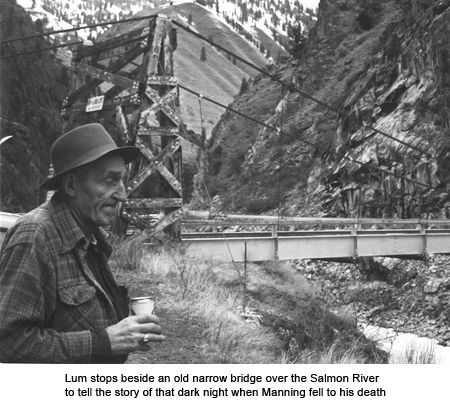 He explained that one night in the 1930s while the bridge was being built, several workers were walking back on the trail. One of the workers in the front had a flashlight and had just gone up and around the small stretch above the cliff. Manning, another of the workers, lagged behind, and as he walked towards the light, he must not have seen that the trail climbed upwards. With the light shining in the dark in front of him it probably appeared to him that the trail went straight. Walking towards the light, he stepped off the cliff and was killed. Since then, the bridge has always been known as the Manning Bridge.
He explained that one night in the 1930s while the bridge was being built, several workers were walking back on the trail. One of the workers in the front had a flashlight and had just gone up and around the small stretch above the cliff. Manning, another of the workers, lagged behind, and as he walked towards the light, he must not have seen that the trail climbed upwards. With the light shining in the dark in front of him it probably appeared to him that the trail went straight. Walking towards the light, he stepped off the cliff and was killed. Since then, the bridge has always been known as the Manning Bridge.
Lum also bragged how he was the first to cross Manning's bridge. One night when the steel framework was in place and before the workers had begun to cover the top of the bridge with timbers, he drove his automobile to the edge. Hopping from beam to beam, he placed a couple of boards just wide enough for his automobile tires. He drove to the edge of the first set of boards and then placed two more boards down and drove to the edge of those. Then, balancing on the beams, he walked back and got the first set of boards and set those in front and continued to drive and set boards down until he had driven all the way across.
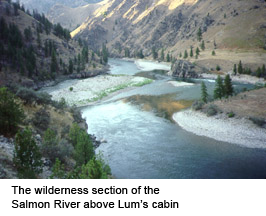 After the Manning Bridge, the road narrows even more and has no shoulder, dropping straight into the river. Several times on that last portion of the trip, I watched horrified as Lum drifted towards the edge of the road, but he always corrected, steering his truck back on track.
After the Manning Bridge, the road narrows even more and has no shoulder, dropping straight into the river. Several times on that last portion of the trip, I watched horrified as Lum drifted towards the edge of the road, but he always corrected, steering his truck back on track.
At his cabin as he puttered around making dinner for me, he talked of his skiing job. In the 1930s each weekend, he would ski 10 miles south of his cabin up the Carey Creek drainage to the Kimberly Mine where he would pick up, of all things, parachutes. Because winter closed off transportation routes to the mine, the parachutes were used for the air dropping of supplies. Parachutes were a valuable item, and no further supplies could be dropped to the miners unless someone carried the parachutes back out. That was Lum's job.
Lum would load approximately 80 pounds of chutes in his pack and then take off down the steep trail leading back to the Salmon River. "I didn't follow any trails, I just took off down the drainage," he lectured me.
Lum's face bunched up in a broad smile and a far-away look came to his eyes. I could see him drifting back, and then he was there: trees rushing by him, jacket flapping in the wind, the vastness of the mountains before him as he flew down the slopes above the Salmon River.
He used a single pole between his legs to slow himself down as he made the descent. "Hell," he said, waving his arms and carried away by excitement, "when you get going 40 miles per hour, you need that pole. You got to stop!"
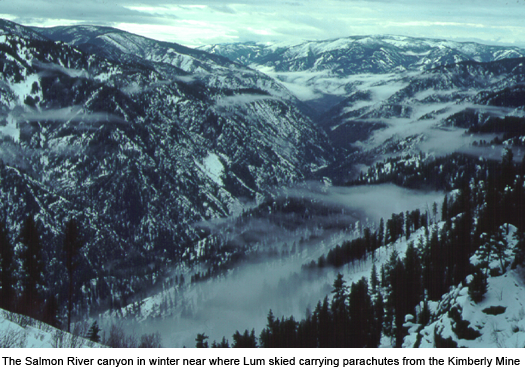
.
All the time he was telling me stories of skiing, he had been preparing something on the stove. When he finally put the plate down in front of me, I lost my appetite. It was the worst looking concoction I'd ever seen: black, brown and white lumps. He called it "maiden heads," but when I had a close look at the jar in his waste basket sometime later, I found that he had fried up pickled cauliflower.
Lum had been draining a whiskey bottle all this time and as the night went on, he began to mumble and become incoherent. Eventually, he fell asleep on the couch. I went around and turned off most of the lights in the house and slipped into my sleeping bag. Things got quiet. I started drifting off to sleep.
All of a sudden, Lum was yelling.
"My lights! My lights!" he cried. "Who turned off my lights? Who turned off my lights?"
I jumped out of my bag and quickly turned on some lights. "It's all right," I reassured Lum, thinking that the whiskey had been giving him bad dreams.
He stared at me with an unnerving wild look. I tried to step back, but he grabbed my arm with a big, gnarled hand, startling me by the power that he still possessed in his old body.
"Never, never, never turn off Lum's lights," he shouted. "Never, never turn off Lum's lights." Then he let go and fell back to sleep on the coach.
Hoping that Lum would stay asleep this time, I left all of his lights on. Unfortunately, he was a fitful sleeper. Every so often he would wake and mumble or shout something unintelligible. Unable to sleep and uneasy with his drunken dreams, I eventually went outside where it was quiet, and I finally went to sleep on his porch.
In the morning, I learned what the ruckus had been about. The power for his cabin came from a generator on a stream, and without the electric load that the lights in his cabin provided, the generator would burn out. By turning out all his lights, I risked destroying his whole electrical system. Fortunately, everything was working fine that next morning, and I was spared the great embarrassment of being known along the Salmon River as that damn fool that burned out Lum's generator.
* * *
 Before I left later in the day, he showed me his skis. He had made them, and the beautiful reddish hue of the skis, he told me, came from alder. I was amazed at how much the shape and size of Lum's skis resemble their present day counterparts. His simple but elegant wood skis had all the basic design components of today's high-performance models made from fibers and plastic resins. Lum had, of course, added his own touches, but when he was younger, he had been a diligent student, learning how fine skis were constructed from other ski craftsman. What he put into his skis was really the accumulated knowledge of generations.
Before I left later in the day, he showed me his skis. He had made them, and the beautiful reddish hue of the skis, he told me, came from alder. I was amazed at how much the shape and size of Lum's skis resemble their present day counterparts. His simple but elegant wood skis had all the basic design components of today's high-performance models made from fibers and plastic resins. Lum had, of course, added his own touches, but when he was younger, he had been a diligent student, learning how fine skis were constructed from other ski craftsman. What he put into his skis was really the accumulated knowledge of generations.
With a draw knife, he had thinned out the ski at the tip and tail, leaving the wood thickest at midski. The thin tip was important in all sorts of loose snow conditions from wet snow to powder. The greater flexibility afforded by its thinness combined with the tip's curvature, allowed the tip of the ski to rise and plane on the top of the snow, instead of diving into the snow. If you've ever broken a ski tip, you know how miserable it can be to make any forward progress when the tip dives into the snow.
The thick midski provided Lum with edging control when snow conditions in the mountains were icy or crusty. And on those deep powder days, when Lum would put his single pole between his legs and rocket down the fall-line, the slight flexibility in the tail helped the ski bow upwards and float through the snow.
The curvature of the tip was obtained by placing the tip of the ski in a pot of boiling water. When the wood became pliable, Lum bent the tip up and clamped it in a mold until it had cooled.
 Originally, he had held his boot to the ski with a leather strap binding, but later he mounted a set of metal bindings providing him better control. Just in front of the bindings, he had attached a wooden thread spool which was used to tie on climbers or skins for going up steep hills. When I asked him what sort of climbers he used, thinking that a sleek pair of seal skin climbers used by arctic explorers would look nice against the red wood of his skis, he told me that the material from the leg of a worn out pair of Levi's did the job just fine.
Originally, he had held his boot to the ski with a leather strap binding, but later he mounted a set of metal bindings providing him better control. Just in front of the bindings, he had attached a wooden thread spool which was used to tie on climbers or skins for going up steep hills. When I asked him what sort of climbers he used, thinking that a sleek pair of seal skin climbers used by arctic explorers would look nice against the red wood of his skis, he told me that the material from the leg of a worn out pair of Levi's did the job just fine.
He seemed perplexed why anyone would be interested in his skiing stories or skis, and before I drove off, he offered me his skis. "I can't possibly take them," I said. But he wouldn't hear any arguments to the contrary and insisted I take them. To this day, Lum's skis, another old pair of skis and a canoe paddle that was hand made by my friend, Walt Blackadar, are my most prized possessions.
* * *
I visited Lum on a couple of other occasions. Then one year, I heard the news of his death. Knowing Lum, it didn't come as a surprise. Lum had been in Riggins, perhaps picking up his monthly Social Security check as he had when I first met him. Returning home, he drove off the narrow road and his pickup plunged into the Salmon River.
What I had learned from Lum was invaluable. He came along at a time when I most needed him, providing me a with a vital link to the past. But I also like to think that maybe in some small way that I returned Lum's favor. Perhaps, for the hours that I spent with him, I was able to provide him with a little companionship, an appreciative ear, and a chance for him to relive, once again, those free and wonderful days when on skis, he flew down the steep hillsides of the Salmon Canyon.
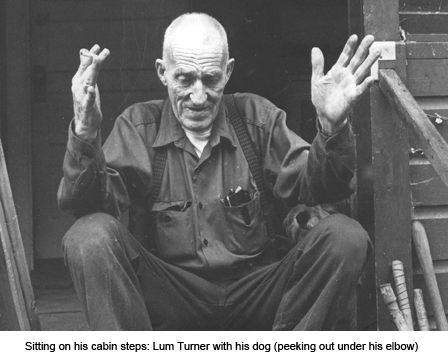
END
A Great Resource of Old Skiing Stories...
|
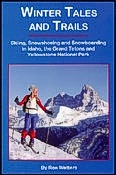 |
The book is truly a classic, one reviewer calling it the "standard by which other guidebooks are judged." Click here for more information on Winter Tales and Trails. . |
|
. Other Resources
The story about Lum Turn takes place along Idaho's River of No Return (Salmon River). One of the best books on the colorful history of the old-timers that lived along the river is Cort Conley's River of No Return. More Information.
A beautifully illustrated book is now available of the River of No Return country. Entitled Salmon River Country, the book is by award-winning photographer Mark Lisk and writer Stephen Stuebner. It's a colorful view of Salmon River Country and some of the hardy people who live and work along the river. More Information |
|
Top of Page

